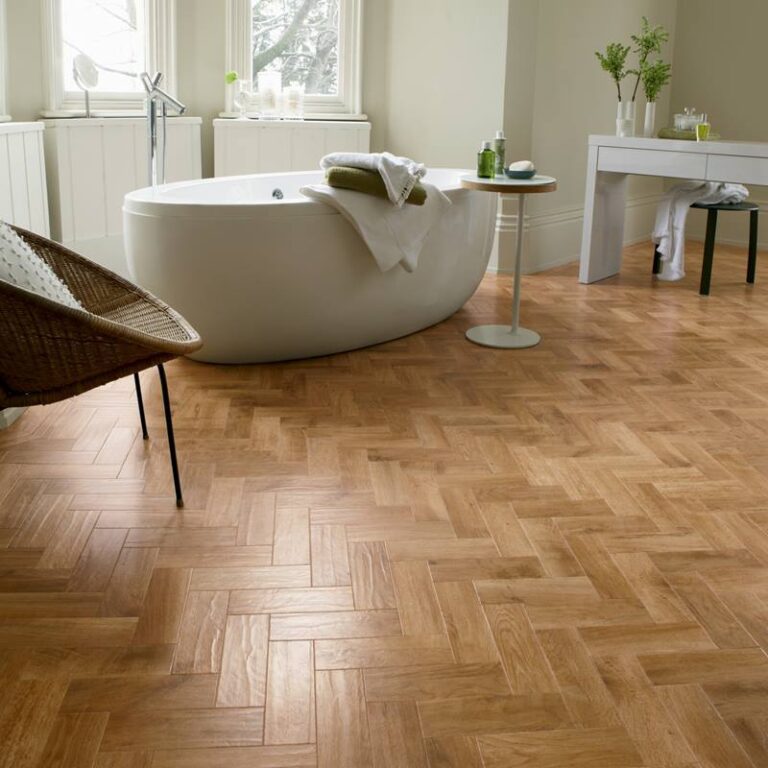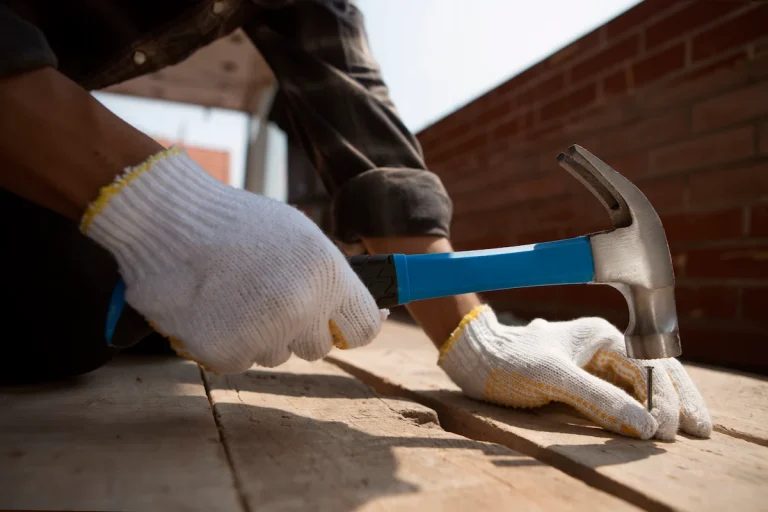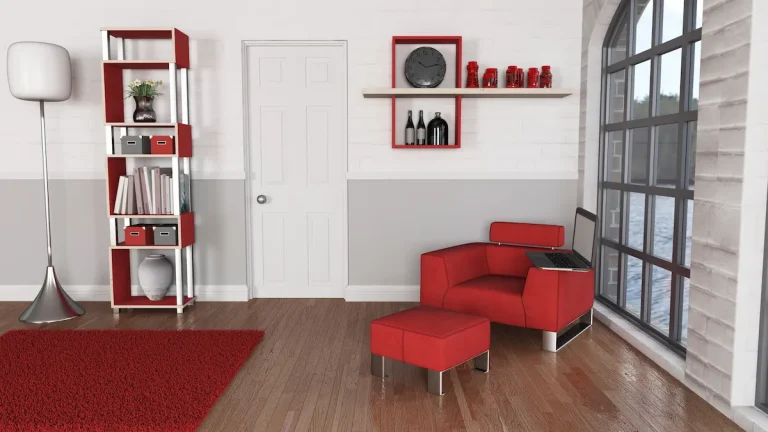Laminate flooring vs. engineered wood, which is the right choice? If you are considering laminate flooring or engineered wood flooring for your home but are not sure which one is the better option, let’s discover the answer together.
We explore the similarities and differences between these two popular flooring types, from the materials used to the installation process, durability, maintenance, cost, and even environmental impact.
Find out everything you need to know to make an informed decision, whether you’re looking for a high-traffic solution, environmentally friendly option, or the best choice for allergies. Let’s dive in and discover which flooring option suits your needs best.
What Is Laminate Flooring?
Laminate flooring is a widely used and adaptable flooring solution that replicates the appearance of natural materials like wood, stone, or tile. Praised for its durability, affordability, and low maintenance, it is a practical option for many homeowners.
Constructed with multiple layers, laminate flooring typically includes a protective wear layer, a design layer with realistic imagery, a sturdy core for structural support, and a moisture-resistant backing. This layered design enhances its lifespan while providing resistance against scratches, stains, and fading from sunlight.
Available in various textures and finishes—such as embossed, hand-scraped, or smooth—laminate flooring offers both visual appeal and versatility, making it suitable for a range of interior styles.
See product: Quick-Step Classic Desert Greige Oak
See product: Montique 12mm Exquisite Barnwood Oak
See product: Elka 8mm V-Groove Pebble Oak
What Is Engineered Wood?
Engineered wood flooring, or engineered hardwood, mimics the look of solid wood while offering enhanced durability and stability. It features a real wood veneer on top for an authentic appearance, supported by multiple plywood or HDF core layers arranged in a cross-grain pattern to resist temperature and humidity changes. A bottom layer of hardwood or softwood adds extra support, making it a strong and reliable flooring option.
See product: Ted Todd Project Bourne – Wide Plank (1.86m x 190mm)
See product: Elka 12.5mm Real Wood Fawn Oak
See product: Lionvest Engineered – 457 – Smoked & UV Oiled Rustic
The Differences Between Laminate Flooring vs. Engineered Wood
While both laminate flooring vs. engineered wood offer durable and versatile options for homeowners, they differ significantly in their composition and installation requirements. Laminate flooring is primarily composed of synthetic materials, whereas engineered wood consists of real wood layers.
a. Materials Used
The primary distinction between laminate flooring and engineered wood lies in the materials used. Laminate flooring is typically manufactured using recycled wood fibres, while engineered wood incorporates layers of real wood veneer or plywood for a more authentic hardwood appearance.
Recycled wood fibres play a crucial role in the sustainability aspect of laminate flooring, providing a cost-effective and environmentally friendly alternative. On the other hand, the layering of real wood or plywood in engineered wood enhances its durability and aesthetic appeal, mimicking the beauty of solid hardwood while being more adaptable to fluctuating environments. Considering the source of wood materials, laminate often utilises wood scraps and residues from manufacturing processes, reducing waste and promoting eco-friendly practices.
b. Installation Process
The installation process for laminate and engineered wood flooring varies due to their composition. Laminate flooring often features a click-lock system that allows for floating installation, while engineered wood can be installed using the tongue and groove method or glued down depending on the subfloor.
When installing laminate flooring with a click-lock system, it’s crucial to start by preparing the subfloor, ensuring it is clean, level, and dry. Begin by laying underlay to provide cushioning and sound absorption. Then, starting in a corner, interlock the planks at an angle and gently tap them into place using a rubber mallet.
Conversely, engineered wood flooring requires a bit more precision with the tongue and groove installation method. This involves fitting the tongues of one plank into the grooves of another, creating a secure and seamless connection. For glued-down installations, apply adhesive to the subfloor and press the planks firmly into place.
c. Durability and Lifespan
When considering durability and lifespan, laminate flooring often boasts a higher level of scratch and impact resistance due to its melamine resin top layer and AC rating system. Engineered wood, while durable, may require more maintenance to preserve its natural beauty and longevity.
One key factor contributing to the durability of laminate flooring is the protective melamine resin layer that shields it from scratches and impacts, making it an ideal choice for high-traffic areas in homes or commercial spaces. The AC rating, which measures a laminate floor’s resistance to abrasion, staining, and swelling, further enhances its longevity.
On the other hand, engineered wood, though also durable, needs regular care and maintenance to sustain its aesthetic appeal and structural integrity over time. This maintenance may include periodic refinishing, proper cleaning techniques, and ensuring a stable indoor environment to prevent warping or damage.
d. Maintenance and Cleaning
Maintenance and cleaning routines differ between laminate and engineered wood flooring. Laminate floors are relatively easy to maintain, requiring regular sweeping and occasional damp mopping. Engineered wood, being a natural material, needs more delicate care to prevent water damage and maintain its appearance.
In terms of laminate floors, the key is to avoid excessive moisture, as it can cause the planks to swell. Using a microfibre mop dampened with a mild cleaner is ideal for routine cleaning. Placing felt pads under furniture legs can help prevent scratches on the surface. Learn how to clean laminate flooring.
On the other hand, engineered wood flooring demands more attention to prevent water seepage. It’s best to clean spills immediately, avoiding prolonged exposure to moisture. Using a specialised wood cleaner specifically designed for engineered wood can help maintain its lustre. Learn how to clean engineered wood.
e. Appearance and Aesthetics
In terms of appearance and aesthetics, laminate flooring is known for its wide range of designs and patterns, including options that mimic hardwood, stone, or tile. Engineered wood, on the other hand, offers the natural beauty of real wood, with variations in grain patterns and textures that reflect the authenticity of hardwood floors.
In terms of laminate flooring, the design versatility knows no bounds. From rich mahogany to sleek marble, laminate can emulate the look and feel of various materials. This makes it a popular choice for those seeking a budget-friendly yet stylish flooring option.
Conversely, engineered wood showcases the unique charm of softwood species like oak, maple, or pine. The intricate grain patterns and natural imperfections give each plank its character, adding a touch of warmth and elegance to any room.
f. Cost
Cost considerations play a significant role in choosing between laminate and engineered wood flooring. Laminate flooring is generally more budget-friendly and offers a cost-effective alternative to hardwood, making it an attractive option for those seeking affordability. Engineered wood, while pricier, provides a balance between cost and the authentic appeal of real wood flooring.
When comparing prices, laminate flooring is often more economical to purchase and install than engineered wood. The lower price point of laminate does not compromise on quality, offering durability and easy maintenance, which can help save on long-term expenses. On the other hand, engineered wood may present a higher initial investment, but it brings a sense of luxury and value to a home, enhancing its overall aesthetics and resale potential.
Laminate Flooring vs. Engineered Wood: Which Is Better?
Deciding whether laminate flooring vs. engineered wood is better depends on various factors such as budget, aesthetic preferences, durability, and specific use cases, with each option presenting its own set of pros and cons that cater to different needs.
1. For High Moisture Areas
For high moisture areas, laminate flooring is generally preferred due to its superior water resistance compared to engineered wood flooring, which can be susceptible to moisture damage despite its enhanced stability over solid wood.
Engineered wood flooring, while more stable than solid wood, is still prone to warping and swelling when exposed to consistent moisture. On the other hand, laminate flooring is constructed with a moisture-resistant layer that helps protect its core from water damage.
When considering options for bathrooms and kitchens, laminate flooring is often chosen for its ability to withstand spills and humidity without compromising its durability. It’s worth noting that excessive moisture exposure should still be avoided to maintain the longevity of the flooring.
2. For High Traffic Areas
Engineered wood is considered a better option for high-traffic areas. Engineered wood is made from real wood veneer layers bonded together with adhesives, making it more durable than laminate, which is composed of synthetic material with a printed wood grain image. Engineered wood can withstand the wear and tear of heavy foot traffic more effectively over time.
The combination of durability, appearance, moisture resistance, and long-term value makes engineered wood flooring a preferred choice for high-traffic areas compared to laminate flooring.
3. Environmentally Friendly
In terms of environmental impact, engineered wood flooring is considered more eco-friendly compared to laminate. Engineered wood often utilises recycled wood materials and minimises waste, making it a sustainable choice for environmentally conscious homeowners.
Recycled wood in engineered wood flooring not only reduces the demand for new timber but also helps in recycling wood that would otherwise end up as waste. This process aligns with the principles of sustainability by promoting the efficient use of resources. Engineered wood production involves advanced technologies that optimise the utilisation of raw materials, further contributing to waste reduction. By choosing engineered wood over laminate, homeowners can make a positive impact on the environment while enjoying a durable and stylish flooring option.
4. Better Water Resistance
In terms of water resistance, laminate flooring typically offers better moisture protection compared to engineered wood. Some laminate products even come in waterproof versions, making them suitable for areas prone to moisture exposure such as bathrooms or kitchens.
These waterproof laminate options are specifically designed to resist water infiltration, providing a durable and long-lasting flooring solution for high-moisture areas. The innovative technology used in laminate production creates a protective barrier that prevents water absorption, thus safeguarding against warping, swelling, and mould growth.
The ease of installation and maintenance of waterproof laminate makes it a popular choice for homeowners seeking a practical and stylish flooring option. With a wide range of designs and finishes available, you can achieve the look of natural wood or stone without compromising on performance in damp environments.
5. For Easy Installation
For ease of installation, laminate flooring is generally considered more user-friendly compared to engineered wood. Laminate often features a simple click-lock system that facilitates floating installation, while engineered wood may require more expertise, especially when dealing with underfloor heating systems.
While laminate flooring can be a DIY-friendly project due to its click-lock design, which allows planks to easily snap together without the need for adhesives or nails, engineered wood installation might demand more precision and knowledge. Engineered wood planks are often a tongue-and-groove style, requiring careful alignment and a sound subfloor for proper attachment.
The real challenge with engineered wood arises when it comes to installing it over underfloor heating systems. The fluctuating temperatures and moisture levels associated with underfloor heating can impact the stability and performance of engineered wood floors, making proper acclimatisation and installation critical to avoid issues such as warping or gaps.
6. For Better Sound Absorption
In terms of sound absorption, engineered wood often outperforms laminate flooring due to its solid wood construction. Engineered wood’s dense layers provide better acoustics by absorbing and dampening sound, creating a quieter and more comfortable indoor environment than laminate flooring.
One of the key factors contributing to engineered wood’s superior acoustics is its multi-layered composition, which consists of a real wood top layer bonded to high-quality plywood or fibreboard beneath. This construction adds a level of density and stability that enhances sound attenuation throughout the room.
Unlike laminate flooring, which is typically made of synthetic material, engineered wood’s genuine wood component contributes significantly to its sound-absorbing capabilities. This natural material has inherent properties that allow it to reduce impact noise and minimise sound reverberation, resulting in a more peaceful living space.
7. For Resale Value
When considering resale value, engineered wood flooring tends to hold a higher appeal compared to laminate.
Homeowners looking to enhance the marketability of their property often turn to real wood floors to elevate the overall aesthetic and perceived value. The durability and longevity of engineered wood make it a wise investment for those concerned with long-term maintenance and upkeep costs. The versatility of engineered wood allows for a range of styles and finishes, catering to diverse buyer preferences. Potential buyers are drawn to the warmth and elegance that real wood floors bring to a home, creating a luxurious atmosphere that can significantly impact the selling price.
8. Better For Allergies
In terms of allergy concerns, both laminate and engineered wood flooring offer hypoallergenic benefits compared to carpeting. Due to their smooth surfaces, these flooring options minimise the accumulation of dust, pet dander, and other allergens, making them suitable choices for individuals with respiratory sensitivities.
Unlike carpeting, laminate and engineered wood flooring do not trap allergens within fibres, allowing allergens to be easily swept or mopped away, helping to maintain a cleaner environment. These hard flooring options are more resistant to moisture, preventing mould growth, which can trigger allergic reactions in sensitive individuals.
The easy maintenance of laminate and engineered wood flooring makes them ideal for allergy prevention, especially for those who suffer from conditions like asthma or hay fever. By choosing these hypoallergenic flooring materials, individuals can create a healthier indoor space that promotes better respiratory health.
9. More Prone to Damage
In terms of susceptibility to damage, laminate flooring is generally more resistant to scratches and stains compared to engineered wood. Engineered wood, being real wood, may be more prone to visible damage over time, especially in high-traffic areas or households with pets.
One of the key advantages of laminate flooring is its exceptional scratch and stain resistance, making it a popular choice for busy households. This type of flooring is designed to withstand the wear and tear of daily life, offering durability and easy maintenance.
On the other hand, while engineered wood lends a touch of elegance with its authentic wood appearance, it requires more care to protect it from scratches and stains, particularly in areas with heavy foot traffic or where pets roam freely. It’s crucial to consider these factors when selecting the most suitable flooring option for your home.
10. For a More Natural Look
For a more natural appearance, engineered wood flooring is the preferred choice as it features a real wood top layer, providing an authentic look that laminate flooring, despite its realistic photographic layer, cannot fully replicate.
Engineered wood flooring tends to have a more substantial feel underfoot compared to laminate, as the multiple layers of real wood give it a solid and sturdy quality. The genuine wood top layer in engineered wood flooring also allows for refinishing, enabling you to refresh its appearance over time.
This durability and ability to be refinished are key advantages that set engineered wood apart from laminate, which typically cannot be sanded and refinished due to its composition. Regarding visual appeal and longevity, engineered wood flooring stands out as a premium choice for those seeking the timeless beauty of wood in their flooring.
11. For Budget-Friendly Options
For budget-friendly options, laminate flooring stands out as the more economical choice, offering a visually appealing and durable solution at a fraction of the cost of engineered wood.
Laminate flooring is not only cost-effective but also easy to install, making it a popular choice among DIY enthusiasts. Its versatility allows for a wide range of styles and designs, mimicking the look of natural wood or stone. Furthermore, laminate flooring is highly resistant to scratches, stains, and fading, making it ideal for high-traffic areas in homes or offices.
On the other hand, engineered wood provides a more authentic wood appearance and is often considered a higher-end option despite being pricier. While it offers the warmth and luxury of real wood, it may require more maintenance and refinishing over time.
So, is engineered wood better than laminate? Determining whether engineered wood or laminate is better depends on various factors such as your specific needs, budget, and preferences.
If you prioritise durability, authenticity, and the ability to refinish your flooring, engineered wood may be the better option. However, if affordability, water resistance, and easy installation are more important to you, laminate flooring might be the preferred choice. It’s essential to weigh these factors against your specific needs and preferences before making a decision.
And, how about the cost? Engineered wood flooring may cost £47 to £200. Then laminate flooring may cost £18 to £47. For the best deal, you can check TEKA Flooring’s product on both, Laminate Flooring and Engineered Wood Flooring.
If you are not sure about the perfect choice for your living space, don’t hesitate to ensure an appointment with our Flooring Expert for consultation. Once you find the right product, fill your basket right away!
Read Also:

































